Udaipur has been called the ‘most romantic spot on the continent of India‘, the ‘Venice of Rajasthan’ and the ‘City of lakes’. The old city, sitting on Pichola Lake, is a cupola crowned area of hues of icing sugar, creams and honeysuckle. The ‘new’ city is an unimaginative collection of undistinguished buildings that has grown up on zinc smelting. Surprisingly, it is the old city that everyone comes to enjoy and it is possible to spend many days exploring all the gems it has to offer.
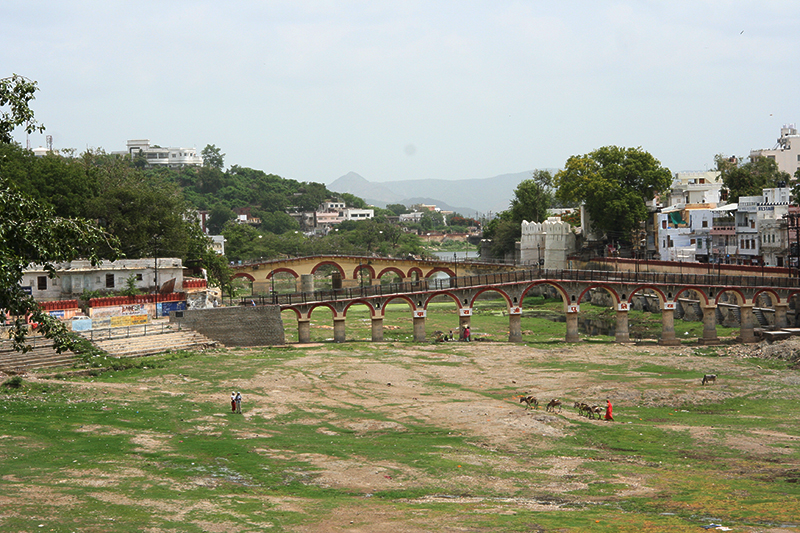 Udaipur was founded in 1568 by Maharaja Udal Singh II after he came across a holy man meditating on a hill near Pichola Lake. The holy man advised the Maharaja to build a new city on the very spot they met and, over the next ten years a great deal of building work was undertaken with several intermissions to fight off invading Mughal forces. The lake around which the city was built was significantly enlarged by flooding much of the surrounding area but remained very shallow and has a habit of drying up in times of drought. During our visit, is was reduced to a pond and a puddle in which children played, dhobi wallahs (clothes washers) slapped clothes and cattle wandered looking for grazing. We were able to walk across it during our first few days until the monsoon arrived and began to fill it once again. From its bed to the uppermost levels of its capacity is about 8 metres in height and its current low water is a result of poor rains over the last 3 years.
Udaipur was founded in 1568 by Maharaja Udal Singh II after he came across a holy man meditating on a hill near Pichola Lake. The holy man advised the Maharaja to build a new city on the very spot they met and, over the next ten years a great deal of building work was undertaken with several intermissions to fight off invading Mughal forces. The lake around which the city was built was significantly enlarged by flooding much of the surrounding area but remained very shallow and has a habit of drying up in times of drought. During our visit, is was reduced to a pond and a puddle in which children played, dhobi wallahs (clothes washers) slapped clothes and cattle wandered looking for grazing. We were able to walk across it during our first few days until the monsoon arrived and began to fill it once again. From its bed to the uppermost levels of its capacity is about 8 metres in height and its current low water is a result of poor rains over the last 3 years.
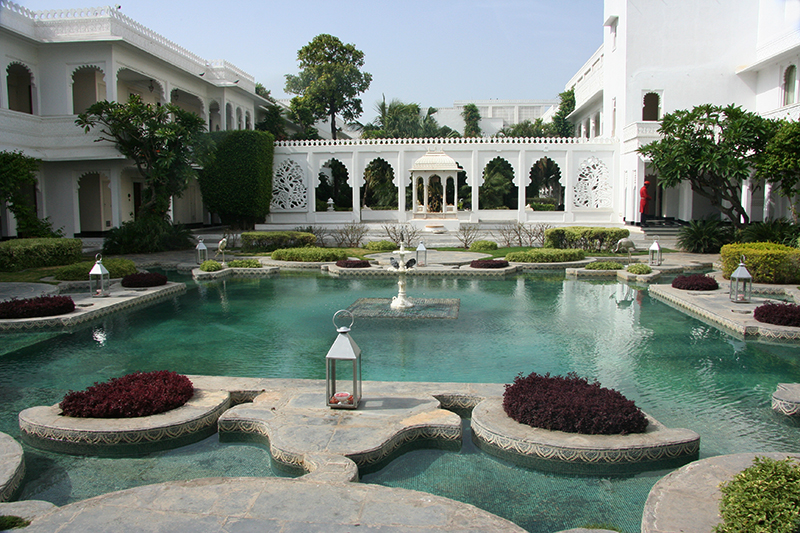 In the centre of the lake sits Jag Niwas Island which is completely consumed by the summer palace of the Maharaja built in 1754. It rises out of the water in brilliant white, proud and grand, with a visual impact not unlike the Taj Mahal. When the lake is full, I am told, it looks as if the whole stunning edifice is floating on water like a sugar coated meringue. It must be the best and finest heritage building in the whole of India thanks to being turned into the Lake Palace Hotel in the 1960s and completely restored, if not to its former glory then greatly in excess of it. It is now one of the world’s ultimate luxury hotels with sparkling white walls, gleaming courtyards and gardens kept in immaculate condition by an army of workers. The attention to detail is stunning – every tile is perfectly aligned, every angle geometrically exact, every inlay true to its original. The restaurants serve food that is sublime: a gourmet’s delight of delicious Indian cuisine, full of aroma and subtle tastes. The bedrooms are spacious and tastefully furnished with the best and most luxurious materials: mattresses with ten million soft springs, feather pillows and finely embroidered covers. The Jacuzzi baths are big enough to hold a party, you can drown in the showers and there is soft toilet paper.
In the centre of the lake sits Jag Niwas Island which is completely consumed by the summer palace of the Maharaja built in 1754. It rises out of the water in brilliant white, proud and grand, with a visual impact not unlike the Taj Mahal. When the lake is full, I am told, it looks as if the whole stunning edifice is floating on water like a sugar coated meringue. It must be the best and finest heritage building in the whole of India thanks to being turned into the Lake Palace Hotel in the 1960s and completely restored, if not to its former glory then greatly in excess of it. It is now one of the world’s ultimate luxury hotels with sparkling white walls, gleaming courtyards and gardens kept in immaculate condition by an army of workers. The attention to detail is stunning – every tile is perfectly aligned, every angle geometrically exact, every inlay true to its original. The restaurants serve food that is sublime: a gourmet’s delight of delicious Indian cuisine, full of aroma and subtle tastes. The bedrooms are spacious and tastefully furnished with the best and most luxurious materials: mattresses with ten million soft springs, feather pillows and finely embroidered covers. The Jacuzzi baths are big enough to hold a party, you can drown in the showers and there is soft toilet paper.
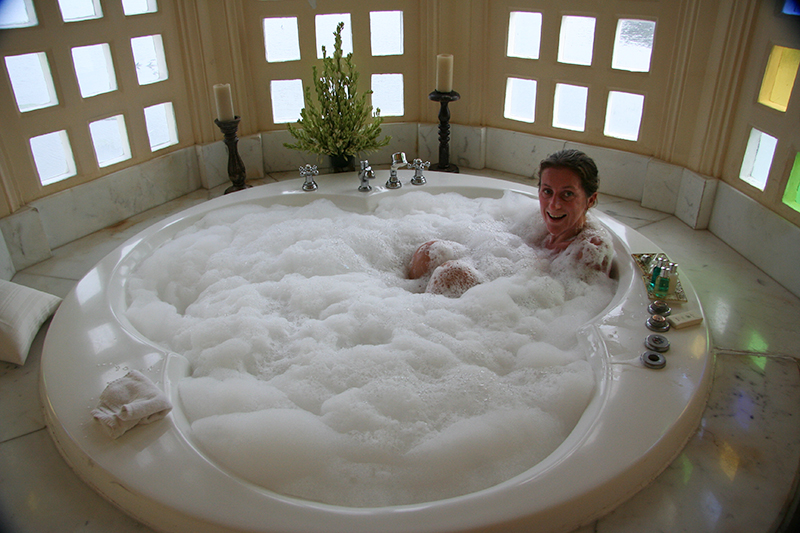 I know all this because we stayed there for one night on our wedding anniversary. Besides, it was the only way to get to see the place. But the prices are eye-poppingly expensive and everything we eat or drink or eat is a financial kick in the crutch. But it was perfect. If the maharaja’s palace was like this I can guarantee he would never have left. My only bitch is that, like all expensive hotels, they charge for wi-fi. In the 21st century why do they do this? In the cheap hotels it is free. And when you are paying a wodge of money, three feet high, for the privilege of staying at such an establishment, it is ridiculous. Not, of course, that I used the internet. I was far too busy doing other things like marveling at the beautiful architecture, admiring the wonderful views, staring at the stunning inlays or just listening to the fountains. Or running around after my gorgeous wife.
I know all this because we stayed there for one night on our wedding anniversary. Besides, it was the only way to get to see the place. But the prices are eye-poppingly expensive and everything we eat or drink or eat is a financial kick in the crutch. But it was perfect. If the maharaja’s palace was like this I can guarantee he would never have left. My only bitch is that, like all expensive hotels, they charge for wi-fi. In the 21st century why do they do this? In the cheap hotels it is free. And when you are paying a wodge of money, three feet high, for the privilege of staying at such an establishment, it is ridiculous. Not, of course, that I used the internet. I was far too busy doing other things like marveling at the beautiful architecture, admiring the wonderful views, staring at the stunning inlays or just listening to the fountains. Or running around after my gorgeous wife.
The next day we had to return to reality, considerably poorer financially but richer for the experience and happy with the world in general. There’s nothing like a bit of luxury to lift the spirits and boost morale. I wouldn’t need any pampering for at least 4 hours.
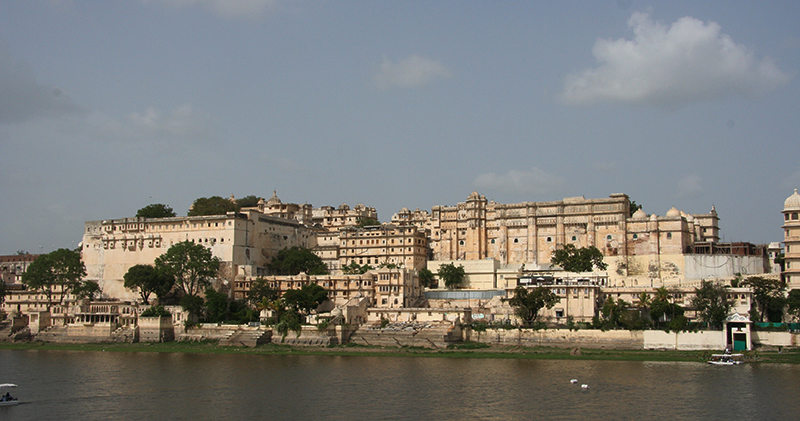 After the opulence of the Summer Palace, we were keen to see how the maharaja really lived and we found our way through the busy streets to the City Palace that dominates much of the east side of the lake. Surmounted by balconies, towers and cupolas, it’s truly enormous. Ten maharajas could live there without ever crossing paths. However, on the inside, the rooms are surprisingly small, rather unhomely and bare. It’s how I would imagine a 1930’s private sanitarium would look and feel: functional, frugal and frightful. I wouldn’t want to live there but Debbie disagreed. She could see herself floating through the corridors, getting the royal household running like a well-oiled machine. However, she said that she’d have to knock some rooms through, install hot water, air conditioning and sanitation, plasma TVs, mobile phone and internet points, iPod ports and, in a first for India, an Aga.
After the opulence of the Summer Palace, we were keen to see how the maharaja really lived and we found our way through the busy streets to the City Palace that dominates much of the east side of the lake. Surmounted by balconies, towers and cupolas, it’s truly enormous. Ten maharajas could live there without ever crossing paths. However, on the inside, the rooms are surprisingly small, rather unhomely and bare. It’s how I would imagine a 1930’s private sanitarium would look and feel: functional, frugal and frightful. I wouldn’t want to live there but Debbie disagreed. She could see herself floating through the corridors, getting the royal household running like a well-oiled machine. However, she said that she’d have to knock some rooms through, install hot water, air conditioning and sanitation, plasma TVs, mobile phone and internet points, iPod ports and, in a first for India, an Aga.
Some of the walls had great paintings depicting past battles, court scenes and hunting expeditions (the maharajas enjoyed slaughtering tigers, leopards, cheetahs and boars, almost as a rite of passage). Occasional rooms had been decorated with mirrors and colours that leapt off the walls and ceilings in a most aggressive manner. It was as if the interior designer not only had a grudge against their ruler but also picked the colours in the dark.
The most beautiful area is known as the Peacock Courtyard. An open area in the centre of the palace surrounded by ornately decorated windows that looked down to marble flooring and walls inlaid with blue peacocks made from glass and stone. It was a charming, cool and peaceful haven away from the busy business of everyday palace affairs.
Next door to the palace is the crystal gallery. To get to it involves a 30 minute walk the whole way round the block to arrive at the other side of a gate we stood next to while visiting the main palace. We also had to talk our way past four different walls of security guards who wanted to see our security passes (eh?), our tickets (a tough one as we hadn’t reached the ticket booth) or just be generally officious. We got whistled at angrily for not walking on the pavement, told to wait while a guard talked to his mate and nearly shot for insubordination. Unsurprisingly, after paying a huge fee for the privilege, we found ourselves the only visitors. They even had to turn on the lights for us.
The Gallery houses an odd assortment of crystal that was ordered by a former maharaja named Saijan Singh from F&C Osler & Co of Birmingham, England in 1877. But he died before the shipment arrived. So it was stored, unopened for over 100 years before being unpacked and placed on display. It has crystal glass furniture – chairs, tables, sofas and beds – as well as crystal perfume bottles, flyswats, candle holders and, naturally wine and water glasses. It is housed in one of those old rooms that smell of decaying fabric and dilapidation, of musty aroma and dust. It all made me think of great great grandparents and, I suppose, it was for their era it was all made. It was interesting for its unusualness (I’m being kind!).
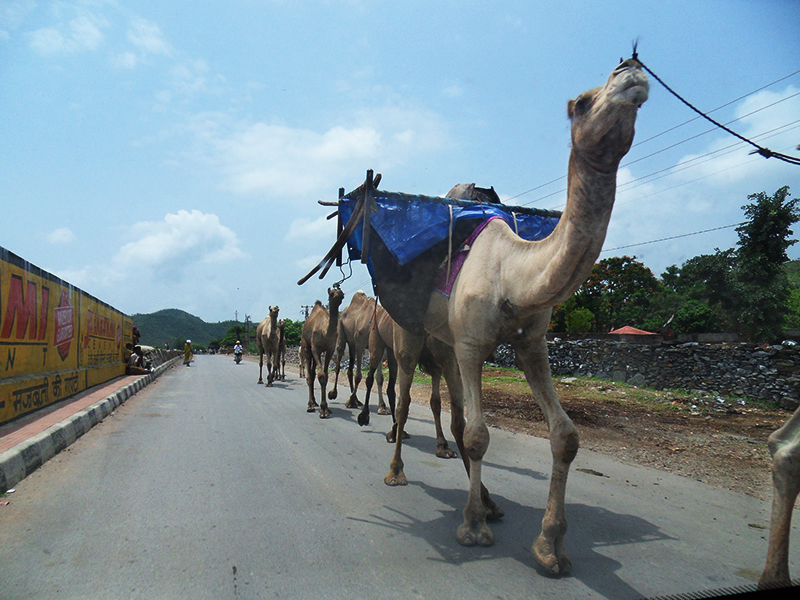 The following day we took a car to reach the remote fort of Kumbalgarh. Along the way we passed varied aspects of rural life. Shepherds moving their sheep and goats along the main highway, trains of camels carrying the worldly possessions of nomadic gypsy people and endless miles of dry fields being worked by fretful farmers. We learnt that the nomads who herded camels were not at all popular. Their women would dance in the villages for coins while their men would steal whatever they could. On the other hand, nomads who herded buffalo were treated with respect. Apparently, these people are ancestors of warrior soldiers, who fought for the state whenever required, and their sacrifice is still honoured.
The following day we took a car to reach the remote fort of Kumbalgarh. Along the way we passed varied aspects of rural life. Shepherds moving their sheep and goats along the main highway, trains of camels carrying the worldly possessions of nomadic gypsy people and endless miles of dry fields being worked by fretful farmers. We learnt that the nomads who herded camels were not at all popular. Their women would dance in the villages for coins while their men would steal whatever they could. On the other hand, nomads who herded buffalo were treated with respect. Apparently, these people are ancestors of warrior soldiers, who fought for the state whenever required, and their sacrifice is still honoured.
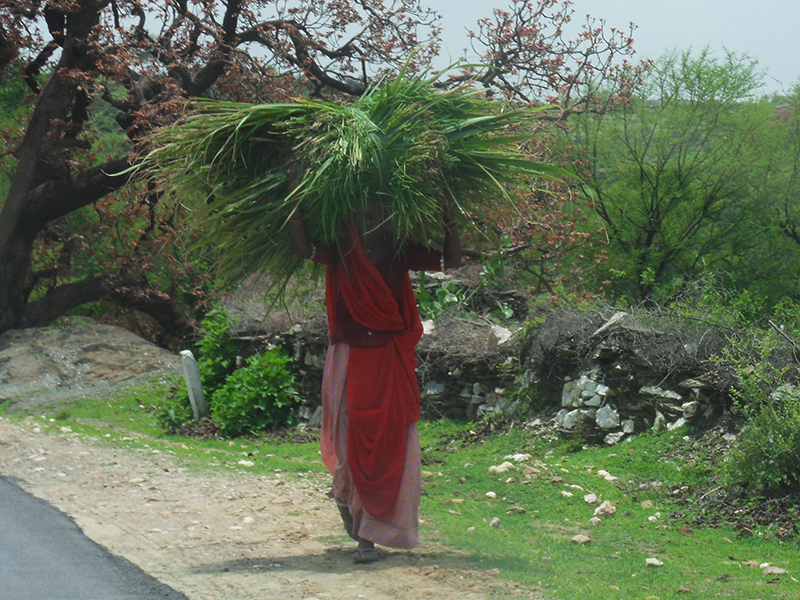 In the fields, women worked together or in partnership with their husbands. They worked in their full saris despite the heat and the dirt and the bright colours of their dress illuminated an otherwise drab landscape. In some fields the young shoots of different crops provided hope for a successful harvest, planted in the expectation of the arrival of monsoon rains. After three years of drought, a good return was needed desperately. Despite many areas of India having plentiful rain, it is still relatively dry in this region.
In the fields, women worked together or in partnership with their husbands. They worked in their full saris despite the heat and the dirt and the bright colours of their dress illuminated an otherwise drab landscape. In some fields the young shoots of different crops provided hope for a successful harvest, planted in the expectation of the arrival of monsoon rains. After three years of drought, a good return was needed desperately. Despite many areas of India having plentiful rain, it is still relatively dry in this region.
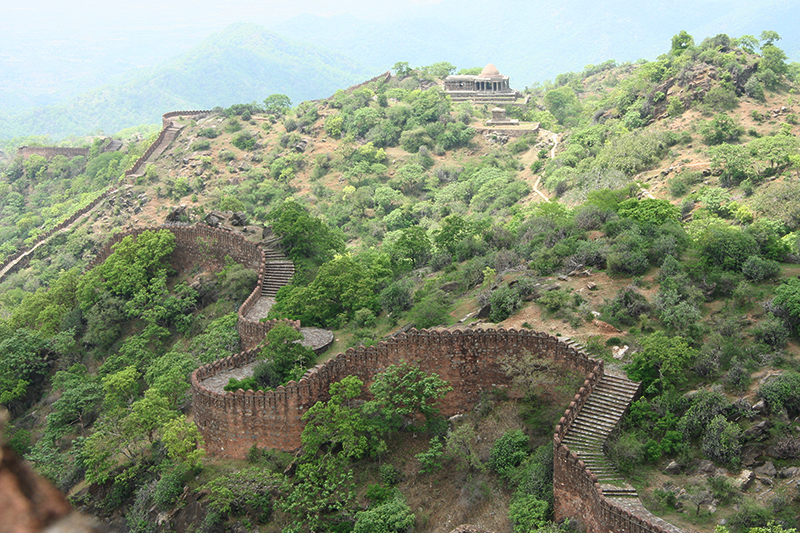 After a long climb through the Aravalli Hills, we suddenly arrived at the Fort of Kumalgarh that stands at the head of a valley. It is an enormous fortification with thick, impenetrable walls that are wide enough in places for 8 horses to ride abreast. The fortifications stretch for 37Km a distance, they claim, makes it the second longest wall in the world after the Great Wall of China. I’m a little skeptical about this claim – for a start, I’m sure Hadrian’s Wall is longer – but it encloses a huge area that not only includes a palace but also 360 temples, 700 canon bunkers, gardens, baoris (wells) and an entire village.
After a long climb through the Aravalli Hills, we suddenly arrived at the Fort of Kumalgarh that stands at the head of a valley. It is an enormous fortification with thick, impenetrable walls that are wide enough in places for 8 horses to ride abreast. The fortifications stretch for 37Km a distance, they claim, makes it the second longest wall in the world after the Great Wall of China. I’m a little skeptical about this claim – for a start, I’m sure Hadrian’s Wall is longer – but it encloses a huge area that not only includes a palace but also 360 temples, 700 canon bunkers, gardens, baoris (wells) and an entire village.
The rulers of Mewar would retreat to this fort in times of trouble and, in its 700 year history, has only been taken once. Even then it took the combined armies of Amber, Marwar and the Mughal Emperor Akbar to breach its mighty defense (and they managed to hold on to it for two days only).
What is excellent about Kumalgarh Fort is that it is the first heritage site that we have visited that is clean, cared for and has been renovated. It is a delight to search amongst the buildings and enjoy the fine architecture without worrying about stepping in something unpleasant and without every room smelling like a toilet.
From the top of the ramparts, there are wide-ranging, magnificent views all around the surrounding countryside. Regrettably, the air was not clear enough to enable us to see great distances (maybe 20 km) but, nonetheless, the occupants could not be taken by surprise such is the commanding position of the mighty 15th century fort.
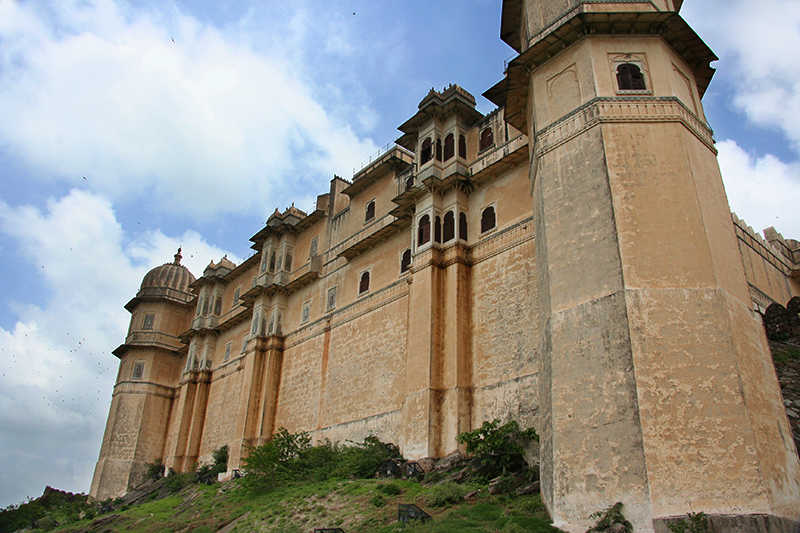 In contrast, the late 19th century Monsoon Palace is in a sorry state. Perched on top of a mountain, 11km outside Udaipur, it looks across to the long lake of Pichola to the old city palace. It was used as an astronomical centre, a hunting lodge and a palace-home during the monsoon. From a distance it looks like a fairytale castle, impossibly balanced on a finger of rock, similar to those in the Bavarian countryside, but once we get up close, it is melancholy and neglected. But, again, the views are superb, particularly, we are told, at sunset. However, this does not apply in the monsoon season when the disappearing sun is shielded behind cloud. I can report that the views were sufficient to enable us to see a great band of rain enveloping the city and race toward us. So we scarpered quick before we got soaked. When it rains, it doesn’t mess about. Everything becomes sodden almost immediately and, within minutes, the roads are flooded, turning the city into a municipal swimming pool.
In contrast, the late 19th century Monsoon Palace is in a sorry state. Perched on top of a mountain, 11km outside Udaipur, it looks across to the long lake of Pichola to the old city palace. It was used as an astronomical centre, a hunting lodge and a palace-home during the monsoon. From a distance it looks like a fairytale castle, impossibly balanced on a finger of rock, similar to those in the Bavarian countryside, but once we get up close, it is melancholy and neglected. But, again, the views are superb, particularly, we are told, at sunset. However, this does not apply in the monsoon season when the disappearing sun is shielded behind cloud. I can report that the views were sufficient to enable us to see a great band of rain enveloping the city and race toward us. So we scarpered quick before we got soaked. When it rains, it doesn’t mess about. Everything becomes sodden almost immediately and, within minutes, the roads are flooded, turning the city into a municipal swimming pool.
Fortunately for us, but not for the locals, the rain didn’t last long and we were able to walk across the old city’s lake to the temple of Jagdish, a fantastically carved little Indo-Ayran structure dating from 1651. The steep steps up to the temple are flanked by elephants that lead to a black stone shrine of the image of Krishna, Lord of the Universe. The outer wall of the temple is carved with hundreds of figures of nymphs, animals and warriors all the way from its base to the summit. A truly impressive little area of tranquility hidden just behind the noisy, bustling streets of the city, where holy men meditate and women come to worship.
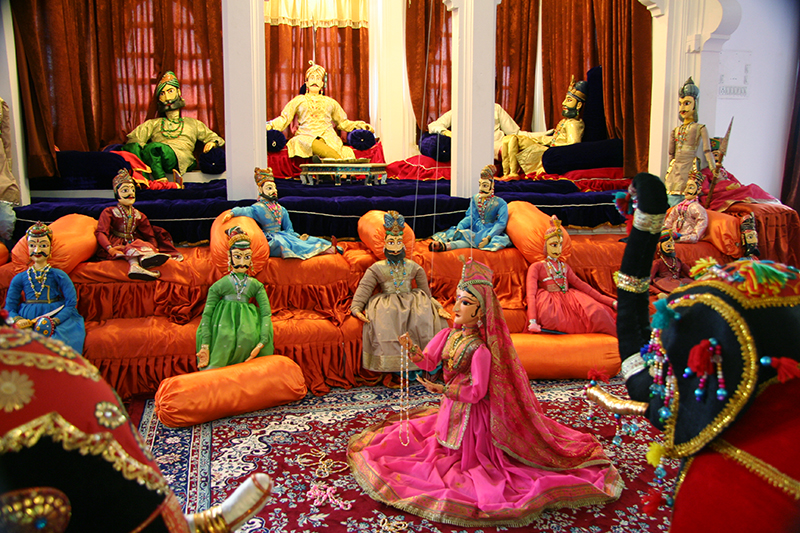 Our final visit was to Bagore-Ki-Haveli, set on the water’s edge opposite our hotel. It is privately owned and in the process of restoration in sympathy with its original design. The restored rooms evoke the period during which the house was originally inhabited and many have cultural displays of art, turbans (we had not appreciated that every trade had a different turban), magnificent puppets and even an exhibition of objects carved from polystyrene!
Our final visit was to Bagore-Ki-Haveli, set on the water’s edge opposite our hotel. It is privately owned and in the process of restoration in sympathy with its original design. The restored rooms evoke the period during which the house was originally inhabited and many have cultural displays of art, turbans (we had not appreciated that every trade had a different turban), magnificent puppets and even an exhibition of objects carved from polystyrene!
We liked Udaipur. The city has a rich and varied heritage with many quite different places of interest. It would be possible to spend a week here without seeing the same type of thing twice. The hassle factor in the streets was lower than we had experienced elsewhere and, on the whole, the people were friendly and open. The food is very good, as indeed it has been all over India so far, and is overwhelmingly vegetarian (a delight for Debbie). The only downside is that I find it fills my guts with air (if you know what I mean). I can’t allow my posterior to get too close to a naked flame because I cannot be held responsible for the ensuing devastation.

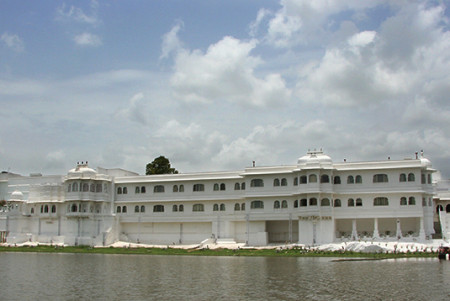

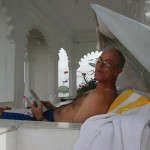
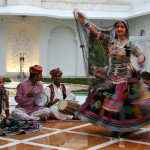
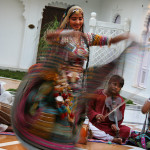
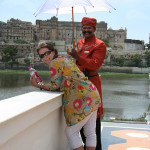

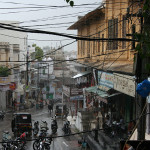
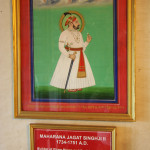
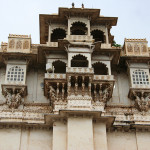
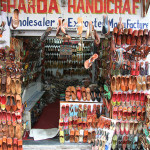

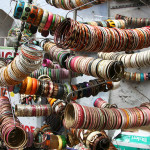
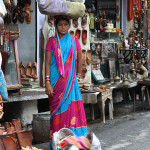
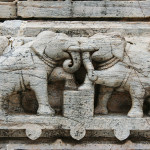
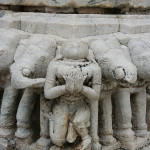
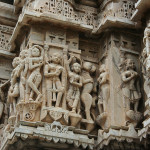
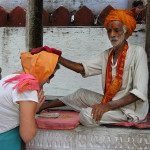
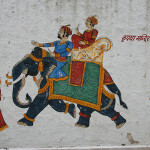
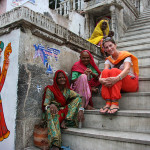
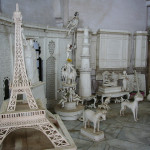
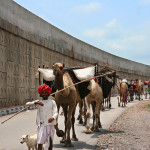
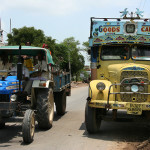
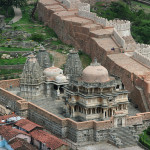
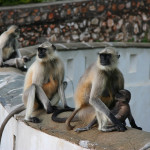
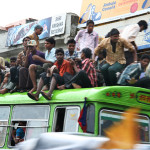
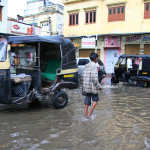
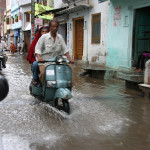
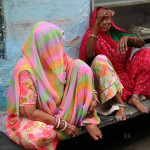
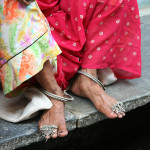
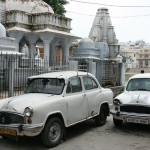
No comments yet.